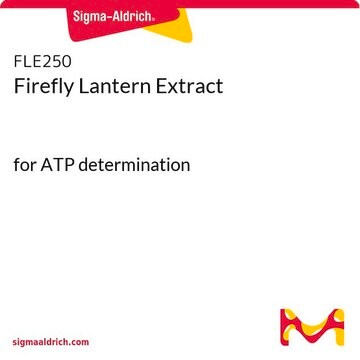L8507
Luciferase from Vibrio fischeri (Photobacterium f)
lyophilized powder
Synonym(s):
Bacterial Luciferase, Luciferase from Photobacterium fischeri
Sign Into View Organizational & Contract Pricing
All Photos(3)
About This Item
Recommended Products
Looking for similar products? Visit Product Comparison Guide
Related Categories
Application
Luciferase from Vibrio fischeri has been used in a study to assess kinetics of light emission and oxygen consumption by bioluminescent bacteria. It has also been used in a study to investigate the sensitivity of dark mutants of various strains of luminescent bacteria to reactive oxygen species.
Features and Benefits
Partially purified, soluble extracts containing FMN-dependent luciferase and NADH- and NADPH-dependent FMN reductases. Produces light in a system containing FMN, NADH or NADPH, and n-decyl aldehyde.
Other Notes
ATCC No. 7744 balance primarily buffer salts and stabilizer.
Physical form
Partially purified lyophilized powder
Signal Word
Danger
Hazard Statements
Precautionary Statements
Hazard Classifications
Resp. Sens. 1
Storage Class Code
11 - Combustible Solids
WGK
WGK 1
Flash Point(F)
Not applicable
Flash Point(C)
Not applicable
Personal Protective Equipment
dust mask type N95 (US), Eyeshields, Gloves
Certificates of Analysis (COA)
Search for Certificates of Analysis (COA) by entering the products Lot/Batch Number. Lot and Batch Numbers can be found on a product’s label following the words ‘Lot’ or ‘Batch’.
Already Own This Product?
Find documentation for the products that you have recently purchased in the Document Library.
Customers Also Viewed
Zachary T Campbell et al.
The Journal of biological chemistry, 284(13), 8322-8328 (2009-01-14)
Unlike the vast majority of flavoenzymes, bacterial luciferase requires an exogenous source of reduced flavin mononucleotide for bioluminescence activity. Within bioluminescent bacterial cells, species-specific oxidoreductases are believed to provide reduced flavin for luciferase activity. The source of reduced flavin in
Nina E Virolainen et al.
Journal of agricultural and food chemistry, 56(23), 11065-11070 (2008-11-13)
Tetracycline (TC) specific luminescent bacterial biosensors were used in a rapid TC residue assay sensitized to meet the EU maximum residue limit (MRL) for TC residues in poultry muscle tissue (100 microg kg(-1)) by membrane-permeabilizing and chelating agents polymyxin B
Zachary T Campbell et al.
Biochemistry, 48(26), 6085-6094 (2009-05-14)
Bacterial luciferase from Vibrio harveyi is a heterodimer composed of a catalytic alpha subunit and a homologous but noncatalytic beta subunit. Despite decades of enzymological investigation, structural evidence defining the active center has been elusive. We report here the crystal
Prashant K Sharma et al.
Surgery, 147(1), 89-97 (2009-09-08)
Bacterial peritonitis is a life-threatening abdominal infection associated with high morbidity and mortality. The rat is a popular animal model for studying peritonitis and its treatment, but longitudinal monitoring of the progression of peritonitis in live animals has been impossible
Loredana Peca et al.
FEMS microbiology letters, 289(2), 258-264 (2008-11-20)
Two whole-cell bioluminescent reporters were constructed by fusing the reporter genes luxAB with the Co(2+) and Zn(2+) inducible coaT promoter or the Ni(2+)-inducible nrsBACD promoter, respectively, in the genome of Synechocystis sp. PCC 6803. The obtained reporters, designated coaLux and
Our team of scientists has experience in all areas of research including Life Science, Material Science, Chemical Synthesis, Chromatography, Analytical and many others.
Contact Technical Service








